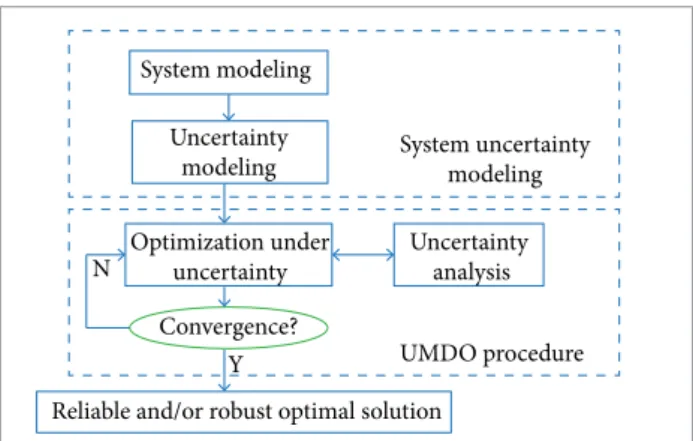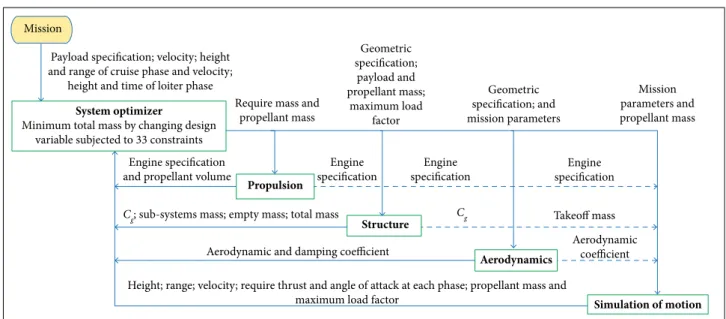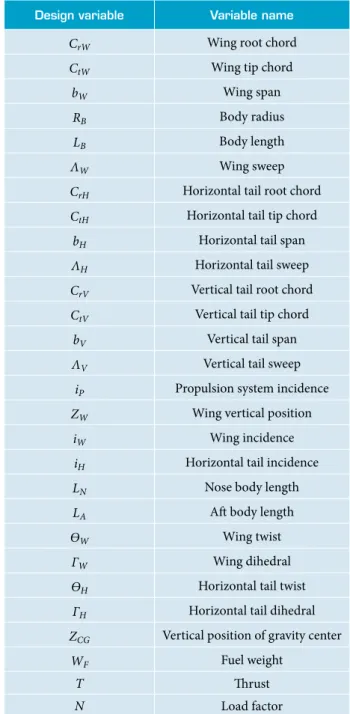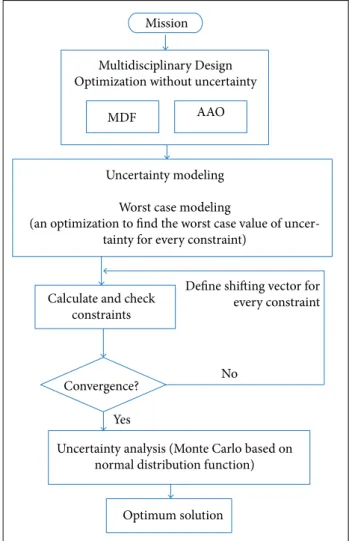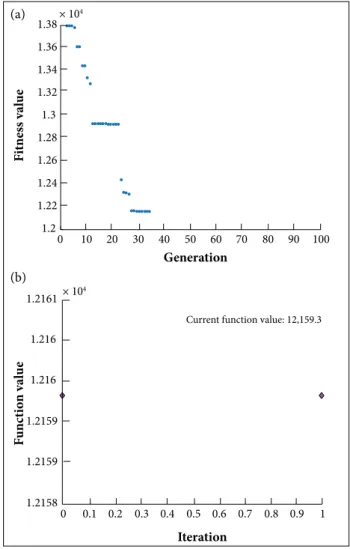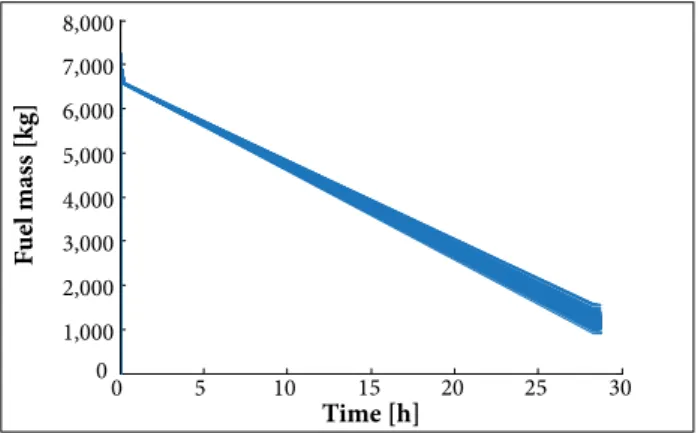ABSTRACT: Uncertainty-based multidisciplinary design optimization considers probabilistic variables and parame-ters and provides an approach to account for sources of uncertainty in design optimization. The aim of this study was to apply a decoupling uncertainty-based multidisci-plinary design optimization method without any dependence on probability mathematics. Existing approaches of un-certainty-based multidisciplinary design optimization are based on probability mathematics (transformation to standard space), calculating an approximation of the con-straint functions in standard space and finding the most probable point, which is the best possible one. The current approach used in this paper was inspired on interval modeling, so it is good when there is insufficient data to develop a good estimate of the probability density function shape or parameters. This approach has been implemented for an existing Unmanned Aerial Vehicle (UAV, Global Hawk) designed for purposes of comparison and validation. The advantages of the provided approach are independence of probability mathematics, appropriate when there is insu- fficient data to approximate the uncertainties variables, appropriate speed to calculate the best reliable response, and proper success rate in the presence of uncertainties.
KEYWORDS: Uncertainty-based multidisciplinary design optimization, MDO, Systemic design, Unmanned Aerial Vehicles design.
Multidisciplinary Design Optimization of
UAV Under Uncertainty
Majid Hosseini1, Mehran Nosratollahi1, Hossein Sadati1
INTRODUCTION
Uncertainty existing at the early phases of the design process influences the system reliability. It is important to manage error early in the design process to decrease the redesign likelihood. Designing complicated and large systems such as aerospace vehicles requires appropriate compromise for gaining balance between multiple coupled targets. The targets include high performance and low costs. he sooner these compromises are understood in design process, the more technology, programming, and cost-related risks can be minimized. here are complicated relationships existing between assignment requirements, constraints, design sub-systems and contradicted targets, which could be coordinated using a suitable strategy of optimization. Multidisciplinary design optimization (MDO) or coordination between multidisciplinary analyses makes understandable more efective solutions during design and optimization of complicated systems. his allows system engineers to look for a vast scope of compromise in a systematic and thoughtful way and to consider more structures in conceptual design phase and before concentrating on inal design.
Preliminary application of optimization in aerospace industries is accompanied by optimization of sub-systems or components such as aerodynamic shape, orbital path, as well as optimization of sub-systems altogether. Anyway, an optimized systemic compound will not be always created through optimization of sub-systems. In aerospace engineering, MDO was irst applied in design of airplanes and to date the method has been used in academic papers and manufactured airplanes (Geethaikrishnan 2003).
In Olds (1993), González et al. (2005), Morris and Kroo (1990), Raymer (2002), Çavuş (2009), Neufeld (2010), Hendrich
1.Malek Ashtar University of Technology – Faculty of Aerospace – Department of Aerospace – Tehran/Tehran – Iran.
Author for correspondence: Majid Hosseini | Malek Ashtar University of Technology – Faculty of Aerospace – Department of Aerospace | Babaii Highway | Zip code: 15875-1774 – Tehran/Tehran – Iran | Email: Mjdhosseini@mut.ac.ir
(2011), Giunta (1997), Buonanno (2005), Iqbal (2009), Mattos and Secco (2013), Eisler (2003), Rowell et al. (1999), Goraj (2005), Lee et al. (2007), Tianyuan and Xiongqing (2009), Jaeger et al. (2013), Ahn et al. (2002), Perez et al. (2004), Sóbester and Keane (2006), Lee et al. (2009), Choi et al. (2010), Zill et al. (2011), and Tekinlap and Cavus (2012), the airplane conceptual designing is done by taking advantage of MDO. In these references, all ighter, passenger, and conventional planes, as well as Unmanned Aerial Vehicles (blended wing body and conventional) are considered. In a systemic attitude towards previous studies, the applied design algorithms are: MDOs in diferent frameworks, such as All at Once (AAO), Multiple Discipline Feasible (MDF), Collaborative (CO), and Bi-level Integrated System Synthesis (BLISS), which are made compatible to diferent optimization methods like evolutionary algorithms and Steepest Descent. Mostly, design criteria are minimum-cost, minimum-weight, and minimum-drag under constraints of scenario performance and functional capability. New researches started to study and develop novel design methods, applying optimized and efficient frameworks in various ields. Aerospace science is included in a way that the application of MDO methods with various single- or multi-level frameworks in aerospace vehicles — such as airplane, launch vehicles, and satellites — is seen referring to reliable papers, being considered as a current theme up to date. Aircrat design under uncertainty has been the subject of some recent studies too. In Ahn and Kwon (2006), it was introduced a BLISS based on Reliability-Based Design Optimization (RBDO) framework to design a simpliied supersonic transport problem (Ahn and Kwon 2006; Sobieszczanski-Sobieski et al. 2000). he study assumed normal distributions with coeicients of variation equal to 0.3 (the ratio of the mean to standard deviation) on each of the 10 design variables considered such as wing area, span, and others describing aircrat geometry. In Smith and Mahadevan (2003), it was solved a spacecrat conceptual optimization problem using RBDO to consider uncertain design variables, relecting the possibility of minor design changes later in the design process. Probabilistic error terms were added to the responses of the aerodynamics and structural analysis output with assumed values of 10%. he optimization problems were solved with several MDO architectures and First-Order Reliability Method (FORM) based reliability analysis methods. he aforementioned studies consider uncertainties in the design variables or parameters such as atmospheric conditions or material properties.
his study aimed to introduce the decoupling of Uncer-tainty-based Multidisciplinary Design Optimization (UMDO) method, applying it to design UAVs as a case study. The following section introduces UMDO methods. hen, it is developed UAV decoupling UMDO algorithm, based on MDO method in single-level frameworks (MDF), using genetic algo-rithm optimization and sequential quadratic programming (SQP). In the section “Implementation of Uncertainty-Based Multidisciplinary Design Optimization Methods and heir Comparison”, the redesign of Global Hawk UAV was made using prepared algorithm, and the comparison was carried out between MDO and UMDO while validating the results.
UMDO METHODS
MDO is a branch of engineering science that applies optimization methods for solving design problems with multiple contexts and themes with coupled parameters. he method is called multidisciplinary optimization or Multidisciplinary System Design Optimization (MSDO). he method allows designers to consider related themes simultaneously (Olds 1993). Any deviation in the designer’s assumptions (i.e., the material strength or the manufacturing precision of a structural member) or approximate analysis methods may result in the failure of the optimized design because the results take place in feasibility bound.
Figure 1. UMDO process(Yao et al. 2011). System modeling
Uncertainty
modeling System uncertainty modeling
UMDO procedure Uncertainty
analysis Optimization under
uncertainty
Reliable and/or robust optimal solution Y
N
Convergence?
distance between the design point and feasibility boundary is calculated. The point in the border of feasibility nearest to the design point is known as MPP. The distance between the design point and MPP is called reliability (β) of the desirable value which is determined by the designer and must have a minimum value. Several methods are used to calculate the MPP and β such as performance measure approach (PMA) and reliability index approach (RIA). These methods are based on FORM but differ in methods of finding MPP (Yu et al. 1997; Tu et al. 1999).
• Possibility-Based Design Optimization (PBDO): when there is not enough information about the uncertainty of design variables, PBDO is appropriate. In this method, the interval or fuzzy theory is used for uncertainty modeling, and interval or FORM-based optimization methods are applied. In general, the results of this method compared to RBDO are the more stable (Du et al. 2006).
Finally, to check the reliability of the obtained optimal solution, uncertainty analysis can be used.
In the second method (decoupling approach), optimization cycles and reliability analysis are separated. For this purpose, 4 steps are carried out:
1. Optimization without uncertainty.
2. Uncertainty analysis on the found answer from step 1 by applying the uncertainty on the desired parameters of the issue.
3. Convergence: if the uncertainties violate the possibility of the answer, a reliable optimal solution is obtained. 4. Lack of convergence: if the uncertainties violate the
possibility of the answer, a shifting vector of the answers must be found for feasibility. hen step 3 is carried out again.
The important thing in this method is finding the shifting vector of answers in a way that the least number of repetitions are needed. One of the ways to find shifting vector is using PMA method to find MPP for each constraint. In this case, the difference between optimal solution without uncertainty and the answer located at the MPP is considered as a shifting vector, and this cycle continues to achieve reliable optimal solution (Du and Chen 2004). In finding shifting vector, the designer’s experience can be very effective.
he irst phase of the process consists on desired system and mathematical uncertainty modeling; the second phase includes optimization in the presence of uncertainty, resistance, and uncertainty analysis, as well as the reliability of the answer. UMDO should match the mathematical uncertainty modeling (probability theory, possibility, etc.) and type of design algorithm (AAO, MDF, CO, etc.). In an optimum problem designing, the failure of the plan will be determined by the problem constraints. If these constraints are identiied by uncertainty variable, the output of the constraints will have some uncertainty. here are 2 ways to resolve the issue through reliability strategies: nested and decoupling approaches.
In the irst method (nested approach), reliability analysis is carried out through optimization cycles for feasibility in the presence of uncertainty. For this purpose, at each iteration of optimizer, reliability analysis is carried out through uncertainty modeling in the parameters in mind. One of the theories available can be used for uncertainty modeling (probability theory, possibility, etc.). Depending on the use of existing theories for uncertainty modeling, there are 2 cases (Rao and Cao 2002):
UAV DECOUPLING UMDO ALGORITHM
Before presenting the design algorithm, it is necessary that various parts of the UAV design be identiied, modeled, and transformed into a sotware code. Other subjects involved in design are: aerodynamic, structure, propulsion, and path simulation.
INTEGRATED DESIGN ALGORITHM WITH UMDO METHOD
UAV design includes, respectively, 11, 15, and 11 common, uncommon, and coupled parameters (a total of 37) in addition to 33 constraints. he above design algorithm, mission deinition, and light scenario exist within which the following parameters are determined: payload geometrical speciication and mass; cruise phase speed, altitude, and range; loiter phase speed, altitude, and duration; in addition to stall speed. Optimization methods applied in system level is a combination of genetic algorithm and SQP, taking the number of design parameters and related constraints into consideration. Combining these 2 methods makes the optimized point resulted from genetic algorithm using SQP method more accurate.
Figure 2 presents UAV’s multidisciplinary design optimi-zation algorithm in MDF structure, in which an optimizer is located at system level within which UAV design parameters (a total of 37) are achieved in a way that, observing the problem’s constraints (a total of 33), optimization criterion (overall mass of the UAV) becomes minimum.
In order to expedite design algorithm and maintain a better convergence, constraints are prioritized, and a certain value is
added to the criterion function against any of these priorities not being observed. his way, optimization algorithm will satisfy constraints while minimizing criterion function. Constraints are prioritized according to their importance: 1) geometrical constraints; 2) constraints related to minimum required thrust; 3) constraints related to minimum require lit; 4) static stability constraints; 5) load coeicient constraints; 6) propulsion mass constraints; and 7) constraints related to performing an mission.
In this framework, disciplines would be feasible through multidisciplinary analyses and internal cycles between cou-pled sub-systems. In other words, internal cycles between coupled sub-systems are continued till all disciplines are feasible in each optimizer evaluation.
he uncertainty of some of these parameters, such as the aerodynamic ones, according to the theory used, is available in the references; however, for the rest of the parameters, there is no authoritative reference. hus, according to the authors’ experience, sources of uncertainty and their values (3σ) are considered in this work as follows:
• Environmental uncertainties include gravity (5% of nominal value) and density (5% of nominal value).
• Uncertainties of the appliance model include mass (5% of nominal value), fuel consumption (5% of nominal value), aerodynamic coeicients (10% of nominal value [5, 17]), and thrust (5% of nominal value).
To provide design algorithm in the presence of uncertainties, it is necessary to identify the sources of the uncertainty. According to the given description, all design methods are based on reliability on
Figure 2. Multidisciplinary design optimization of UAV.
Mission
System optimizer
Minimum total mass by changing design variable subjected to 33 constraints
Propulsion
Structure
Aerodynamics
Simulation of motion Payload specification; velocity; height
and range of cruise phase and velocity; height and time of loiter phase
Require mass and propellant mass
Engine specification and propellant volume
Cg; sub-systems mass; empty mass; total mass
Aerodynamic and damping coefficient Aerodynamiccoefficient Engine
specification
Engine specification
Engine specification
Takeoff mass
Height; range; velocity; require thrust and angle of attack at each phase; propellant mass and maximum load factor
Geometric specification;
payload and propellant mass;
maximum load factor
Geometric specification; and mission parameters
Mission parameters and propellant mass
Fitness function Function name
Minimize takeof weight in order to below mission parameters
VCruise Cruise velocity
HCruise Cruise height
R Range
VLoiter Loiter velocity
HLoiter Loiter height
E Endurance
Payload speciications
VS Stall speed
RN Nose radius
Table 1. Optimization without uncertainty (step 1). Fitness function.
the basis of the mathematics of uncertainty (mapping to a normal distribution space), calculating the border of feasibility and the nearest point from it with a point (MPP). Since the constraints deined in the current problem of UAV are in a way that there is no clear feasibility border, using such methods is very diicult. Here it is presented the method for UAV multidisciplinary optimal design in the presence of uncertainties, which is based on the evolutionary algorithm. he advantage of this method compared to introduction ones is its independence from mathematics of uncertainty and no need for calculating the feasibility border. To perform the design in the presence of uncertainties, the following steps should be taken separately:
1. Optimization without uncertainty (Table 1-3).
2. Uncertainty modeling by the found answer from step 1 as follows: the worst case of uncertainty in a deinite range for any constraint is calculated by an optimization algorithm as below. The parameters of optimization algorithm are uncertainty values, and optimization criteria maximize the impossibility of any constraint (for example, minimizing the duration of the light or an increase in instability). he optimization algorithm in this method, like the original optimization algorithm, is a combination of genetic algorithm and SQP. herefore, its output will be the set of the worst uncertainties for each constraint):
Maximize constraint(i), (i = No. of constraints) By changing (7 parameters): UT, USFC, UWe, UCD, UCL, Ug, Uρ 3. Convergence: uncertainty analysis by applying the set of
the worst uncertainties on the parameters of the problem. If the uncertainties do not violate the possibility of the answer, a reliable optimal solution is obtained.
Design variable Variable name
CrW Wing root chord
CtW Wing tip chord
bW Wing span
RB Body radius
LB Body length
ΛW Wing sweep
CrH Horizontal tail root chord
CtH Horizontal tail tip chord
bH Horizontal tail span
ΛH Horizontal tail sweep
CrV Vertical tail root chord
CtV Vertical tail tip chord
bV Vertical tail span
ΛV Vertical tail sweep
iP Propulsion system incidence
ZW Wing vertical position
iW Wing incidence
iH Horizontal tail incidence
LN Nose body length
LA At body length
ѲW Wing twist
ΓW Wing dihedral
ѲH Horizontal tail twist
ΓH Horizontal tail dihedral
ZCG Vertical position of gravity center
WF Fuel weight
T hrust
N Load factor
Table 2. Optimization without uncertainty (step 1). Design variable.
Calculate & check constraint(i), (i = No. of constraints) in order to mission parameters (VCruise, HCruise, R, VLoiter, HLoiter, E,
Payload Speciicaions, VS, RN) & Uncertainty value (Ui= [UT, USFC, UWe, UCD, UCL, Ug, Uρ])
for i = 1, 2, …, nc
& Opimum design variable: XW, CrW, CtW, bW, RB, LB, ɅW, CrH,
CtH, bH, ɅH, CrV, CtV, bV, ɅV, iP, ZW, iW, iH,
Constraints
VPL+ VF < VW + Vb
bW > 2RB
bH > 2RB
bV > 2RB
CtW < CrW
CtH < CrH
CtV < CrV
ZW < RB
XW + CrW < 0.8LB
LN < 0.5LB
LA< 0.5LB
Cmα< 0without fuel and external payload Cnβ> 0 without fuel and external payload
Cmα< 0 without fuel and with external payload
Cn
β> 0 without fuel and with external payload
Cmα< 0with fuel and without external payload Cnβ> 0 with fuel and without external payload
Cmα< 0with fuel and external payload
Cn
β> 0 with fuel and external payload
WF Opt > WF Required
nOpt > nCalculated
Lit > WTO in stall speed
Lit > WTOin cruise speed
Lit > WTOin loiter speed T > TCalculated in stall speed T > TCalculated in cruise speed T > TCalculated in loiter speed VCruise = VCruise calculated in simulation HCruise = HCruise calculated in simulation
R = RCalculated in Simulation VLoiter = VLoiter calculated in simulation HLoiter = HLoiter calculated in simulation
E = ECalculated in simulation
Table 3. Optimization without uncertainty (step 1). Constraints. 4. Lack of convergence: if the uncertainties violate the
possibility of the answer, a shifting vector of the answers, appropriate for the violated constraint, must be found for feasibility — for example, if the constraints related to light time requirements is not met. he diference between the required fuel and the available one will be added to the latter (required fuel is the output of movement simulation), then step 3 is carried out again.
Ater designing in the presence of uncertainty, its analysis using the Monte Carlo method is performed to check the inal
answer. he UAV multidisciplinary optimal design algorithm in the presence of uncertainties is presented in Fig. 3.
UAV design algorithm in the presence of uncertainties was transformed into a sotware code; through it, the results of re-designing UAV — Global Hawk (RQ-4B) — in the presence of the uncertainties are presented. he results of UAV design have been compared without the presence of uncertainties.
Mission
MDF AAO
Multidisciplinary Design Optimization without uncertainty
Uncertainty modeling
Calculate and check constraints
Define shifting vector for every constraint
No
Yes
Optimum solution Convergence?
Uncertainty analysis (Monte Carlo based on normal distribution function)
Worst case modeling
(an optimization to find the worst case value of uncer-tainty for every constraint)
Figure 3. UAV MDO algorithm in the presence of uncertainties.
IMPLEMENTATION OF UMDO
METHODS AND THEIR COMPARISON
To do so, mission information of this UAV was considered as design code input and the output extracted. hen, outputs were compared to real UAV information. Code inputs for Global Hawk redesign are: 575 km/h of velocity cruise, 28 h of light endurance, maximum altitude of 18 km, and payload mass of 1,360 kg.
In Table 4, by the percentage of success, we wonder what is the percentage of likelihood of fulfillment of all constraints (as explained in previous seasons) in the presence of uncertainty for the final design. As seen in this table, result differences in MDF method with existing information from Global Hawk are between 13 – 23% in mass and less than 9% in geometrical specifications. The following points could be referred to as the reasons for these differences:
• Lack of sufficient information about Global Hawk light scenario.
• Lack of information about airfoil and liting instruments at the time of takeof and landing.
• Lack of information about accurate stall speed and some of functional parameters.
• Lack of information about payload geometric
speciications, sub-systems layout, and fuel.
• Lack of consideration of uncertainties.
Convergence procedure in MDF frameworks is shown in Fig. 4. As can be seen, the success rate of optimal response from MDF algorithm (without uncertainty) is 51 and 100% for decoupled method. The run time of this code in decoupled method is 1,600 s more than the MDF algorithm
Value
Section Decoupling
approach MDF
Real value
39 39
39.9 Wing span (m)
68.25 68.2
63.02 Wing area (m2)
1.3 1.28
1.42 Body diameter (m)
14.5 14.5
14.5 Body length (m)
5,538 5,229
5,868 Empty mass (kg)
14,133 12,159
14,628 Takeof mass (kg)
7,235 5,570
7,400 Propellant mass (kg)
23,107 21,507
-Time of optimization(s)
100 51
-Percentage of success
Table 4. Outputs of design code for Global Hawk redesign in presence of uncertainty.
Figure 4. (a) Convergence trend in GA algorithm ; (b)SQP.
0 10 20 30 40 50 60 70 80 90 100
1.2 1.22 1.24 1.26 1.28 1.3 1.32 1.34 1.36
1.38× 10
4
× 104
Generation
F
it
ness va
lu
e
0 0.1 0.2 0.3 0.4 0.5 0.6 0.7 0.8 0.9 1
1.2158 1.2159 1.2159 1.216 1.216 1.2161
Iteration
F
unc
ti
o
n va
lu
e
Current function value: 12,159.3 (without uncertainty). The total mass obtained from the decoupled method is 1,974 kg more than that of the MDF algorithm.
The total mass obtained from the optimal design algorithm in the presence of uncertainties in decoupled method is 14.1 t. This means that, to compensate the failure probability in multidisciplinary optimal algorithm without uncertainties, the mass is increased in order to increase the success chance from 51 to 100%, considering that the uncertainties have also resulted in less difference between the obtained responses and the real values. Regarding the obtained result, although designing without uncertainties in a more optimal way, it is not reliable.
In Figs. 5 and 6, the results of the Monte Carlo analysis are presented for thousands of performances. In Fig. 7, it is observed the 3-D view; in Fig. 8, the presented charts resulted from redesigned UAV simulation of motion.
(a)
Figure 7. 3-D view of the redesigned UAV.
Figure 6. Monte Carlo analysis: fuel consumption versus time. Figure 5. Monte Carlo analysis: angle of attack and thrust
versus time.
CONCLUSION
The present study introduced MDO and UMDO frameworks in UAVs, implemented and compared as a case study. To this aim, sub-systems and disciplines involved in design were modeled, and a proposed algorithm for conceptual design of UAV was developed based on multidisciplinary optimization method in MDF framework, using genetic algorithm optimization method and SQP. This algorithm includes 11 common parameters, 15 uncommon parameters, 11 coupled parameters (a total of 37) and 33 constraints.
Regarding the results achieved from MDO in the presence of uncertainties for operational UAV, the results are explained as:
• he comparison of the code outputs, results of the movement simulation, and Monte Carlo analysis for multidisciplinary optimal design code output in the presence of uncertainties indicates the correctness and reliability of results of the proposed algorithm. -4
-2 0 2 4 6 8 10 12
0 5 10 15 20 25 30
0 5 10 15 20 25 30 35 40 45
Time [h]
0 5 10 15 20 25 30
Time [h]
Thrust [KN]
α [deg]
0 5 10 15 20 25 30
0 1,000 2,000 3,000 4,000 5,000 6,000 7,000 8,000
Time [h]
F
u
el mass [kg]
0 5 10 15 20 25 30
0 2 4 6 8 10 12 14 16 18 20
Time [h]
Time [h]
Height [km]
0 5 10 15 20 25 30
0 50 100 150 200 250
Velocity [m/s]
• To compensate the failure probability in multidis-ciplinary optimal algorithm without uncertainties, the mass is increased in order to increase the success chance to 100%.
The advantages of the provided approach are: independence from probability mathematics, appropriate when there is insufficient data to approximate the uncertainties variables or develop a good estimate of the probability density function shape, appropriate speed to calculate the best reliable response, and proper success rate in the presence of uncertainties.
Totally, regarding the presence of the uncertainties in the real world, it is better to consider the mass increase penalty in order to increase the reliability of the design. With the help
of this algorithm, we can, according to the deined operation for the UAV and the level of uncertainties of the proposed models in the design, achieve a reliable and optimal answer in the conceptual design phase with the least time and highest accuracy.
AUTHOR’S CONTRIBUTION
Hosseini M and Nosratollahi M, conceived the idea and co-wrote the main text; Hosseini M, prepared the tables and igures. All authors discussed the results and commented on the manuscript.
REFERENCES
Ahn J, Kwon JH (2006) An eficient strategy for reliability-based multidisciplinary design optimization using BLISS. Structural and Multidisciplinary Optimization 31(5):363-372. doi: 10.1007/ s00158-005-0565-6
Ahn J, Lee S, Kim JS. (2002). A robust approach to pre-concept design of UCAV considering survivability. Proceedings of the 9th AIAA/ ISSMO Symposium on Multidisciplinary Analysis and Optimization; Atlanta, USA.
Buonanno MA (2005) A method for aircraft concept exploration using multicriteria interactive genetic algorithms (PhD thesis). Georgia Institute of Technology.
Çavuş N (2009) Multidisciplinary and multiobjective design optimization
of an Unmanned Combat Aerial Vehicle (UCAV) (Master’s thesis). Ankara: Middle East Technical University.
Choi SM, Nguyen NV, Kim WS, Kim S, Lee JW, Byun YH (2010) Multidisciplinary Unmanned Combat Air Vehicle (UCAV) system design using multi-idelity models. Proceedings of the 48th AIAA Aerospace Sciences Meeting Including the New Horizons Forum and Aerospace Exposition; Orlando, USA.
Du L, Choi KK, Youn BD (2006) Inverse possibility analysis method for possibility-based design optimization. AIAA J 44(11):2682-2690. doi: 10.2514/1.16546
Du X, Chen W (2004) Sequential optimization and reliability assessment method for eficient probabilistic design. J Mech Des 126(2):225-233. doi: 10.1115/1.1649968
Eisler CA (2003) Multidisciplinary optimization of conceptual aircraft design (Master’s thesis). Ottawa: Carleton University.
Geethaikrishnan C (2003) Multidisciplinary design optimization strategy in multi-stage launch vehicle conceptual design (PhD thesis). Bombay: Indian Institute of Technology.
Giunta A (1997) Aircraft multidisciplinary design optimization using design of experiments theory and response surface modeling methods (PhD thesis). Blacksburg: Virginia Polytechnic Institute and State University.
González LF, Srinivas K, Périaux J, Whitney EJ (2005) Multidisciplinary design optimization of Unmanned Aerial Vehicles (UAV) using multi-criteria evolutionary algorithms. Proceedings of the 6th World Congress of Structural and Multidisciplinary Optimization; Rio de Janeiro, Brazil.
Goraj Z (2005) Design challenges associated with development of a new generation UAV. Aircr Eng Aerosp Tec 77(5):361-368. doi: 10.1108/00022660510617086
Hajela P (2002) Soft computing in multidisciplinary aerospace design - new directions for research. Progr Aero Sci 38(1):1-21. doi: 10.1016/S0376-0421(01)00015-X
Hendrich TJM (2011) Multidisciplinary design optimization in the conceptual design phase creating a conceptual design of the blended wing-body with the BLISS optimization strategy (Master’s thesis). Delft: Delft University of Technology.
Hu J, Qiu Z (2010) Non-probabilistic convex models and interval analysis method for dynamic response of a beam with bounded uncertaint. Appl Math Model 34(3):725-734. doi: 10.1016/j. apm.2009.06.013
Iqbal LU (2009) Multidisciplinary design and optimization (MDO) methodology for the aircraft conceptual design (PhD thesis). West Lafayette: Purdue University.
Jaeger L, Gogu C, Segonds S, Bes C (2013) Aircraft multidisciplinary design optimization under both model and design variables uncertainty. J Aircraft 50(2):528-538. doi: 10.2514/1.C031914
Lee DS, Gonzalez LF, Srinivas K, Auld DJ, Wong KC (2007) Aerodynamic shape optimisation of Unmanned Aerial Vehicles using hierarchical asynchronous parallel evolutionary algorithms. Int J Comput Intell Res 3(3):229-250.
Mattos BS, Secco NR (2013) An airplane calculator featuring a high-idelity methodology for tailplane sizing. J Aerosp Technol Manag 5(4):371-386. doi: 10.5028/jatm.v5i4.254
Morris SJ, Kroo I (1990) Aircraft design optimization with dynamic performance constraints. J Aircraft 27(12):1060-1067. doi: 10.2514/3.45982
Neufeld D (2010) Multidisciplinary aircraft conceptual design optimization considering idelity uncertainties (PhD thesis). Toronto: Ryerson University.
Olds JR (1993) Multidisciplinary design techniques applied to conceptual aerospace vehicle design (PhD thesis). Raleigh: North Carolina State University.
Perez RE, Liu HHT, Behdinan K (2004) Evaluation of multidisciplinary optimization approaches for aircraft conceptual design. Proceedings of the 10th AIAA/ISSMO Multidisciplinary Analysis and Optimization Conference; Albany, USA.
Rao SS (1992) Reliability-based design. New York: McGraw-Hill.
Rao SS, Cao L (2002) Optimum design of mechanical systems involving interval parameters. J Mech Des 124(3):465-472. doi: 10.1115/1.1479691
Raymer DP (2002) Enhancing aircraft conceptual design using multidisciplinary optimization (PhD thesis). Stockholm: Royal Institute of Technology.
Rowell LF, Braun RD, Olds JR, Unal R (1999) Multidisciplinary conceptual design optimization of space transportation systems. J Aircraft 36(1):218-226. doi: 10.2514/2.2428
Schueller G, Jensen H (2008) Computational methods in optimization considering uncertainties - an overview. Comput Meth Appl Mech Eng 198(1):2-13. doi: 10.1016/j.cma.2008.05.004
Smith, Mahadevan S (2003) Probabilistic methods for aerospace system conceptual design. J Spacecraft Rockets 40(3):411-418. doi: 10.2514/2.3961
Sóbester A, Keane AJ (2006) Multidisciplinary design optimization of UAV airframes. Proceedings of the 47th AIAA/ASME/ASCE/AHS/ ASC Structures, Structural Dynamics, and Materials Conference; Newport, USA.
Sobieszczanski-Sobieski J, Agte JS, Sandusky RR (2000) Bilevel integrated system synthesis. AIAA J 38(1):164-172. doi: 10.2514/2.937
Tekinlap O, Cavus N (2012) Multiobjective conceptual design of an Unmanned Combat Air Vehicle. Proceedings of the 12th AIAA Aviation Technology, Integration, and Operations (ATIO) Conference and 14th AIAA/ISSMO Multidisciplinary Analysis and Optimization Conference; Indianapolis, USA.
Tianyuan H, Xiongqing Y (2009) Aerodynamic/stealthy/structural multidisciplinary design optimization of Unmanned Combat Air Vehicle. Chin J Aeronaut 22(4):380-386. doi: 10.1016/S1000-9361(08)60114-4
Tu J, Choi KK, Park YH (1999) A new study on reliability-based design optimization. J Mech Des 121(4):557-564. doi: 10.1115/1.2829499
Vittal S, Hajela P (2003) Probabilistic design using empirical distributions. Proceedings of the 44th AIAA/ASME/ASCE/AHS/ASC Structures, Structural Dynamics, and Materials Conference; Norfolk, USA.
Yao W, Chen X, Luo W, van Tooren M, Guo J (2011) Review of uncertainty-based multidisciplinary design optimization methods for aerospace vehicles. Progr Aero Sci 47(6):450-479. doi: 10.1016/j. paerosci.2011.05.001
Yu X, Choi KK, Chang KH (1997) A mixed design approach for probabilistic structural durability. Struct Optim 14(2):81-90. doi: 10.1007/BF01812509
